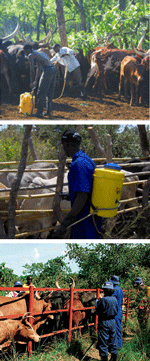STAMP OUT SLEEPING SICKNESS
|
|
Introduction to the stamp out sleeping sickness project
Background to sleeping sickness in Uganda
The spread of sleeping sickness in Uganda
Communication of research to communities and policy makers
|
Welcome to sleepingsickness.org, where the academic and business worlds join forces in an emergency intervention to counter the recent and explosive spreading of this terrible zoonotic disease in Uganda. There is an emerging public health crisis in Uganda with the areas affected by acute sleeping sickness steadily moving towards the areas affected with chronic sleeping sickness. Eight new districts of Uganda have become newly affected in the last 8 years and less than 100 km now separates the diseases. For every person receiving treatment for acute human sleeping sickness in Uganda today, 12 people die undiagnosed. Visual discrimination between the HAT parasites is impossible, diagnosis and treatment differ - convergence of the two diseases would present a catastrophic health problem, impeding diagnosis and treatment. Our project aims to fight against sleeping sickness, the greatest cause of mortality, even ahead of HIV/AIDS in some African countries. Rather than “only” aiming to stop the increase of the human disease by treating the cattle reservoir, this project also aims to prove its efficacy and its sustainability as the further cost of treatment for farmers should not exceed 0.2 USD per animal per month. The scheme has been set up and is jointly managed by the Universities of Edinburgh (UK) and Makerere (Uganda) together with the international veterinary laboratory Ceva Sante Animale (headquartered in France) and further supported by the pan European private equity firm IK Investment Partners (IK).
This website holds no responsibility for the information that external links may contain. |
 |